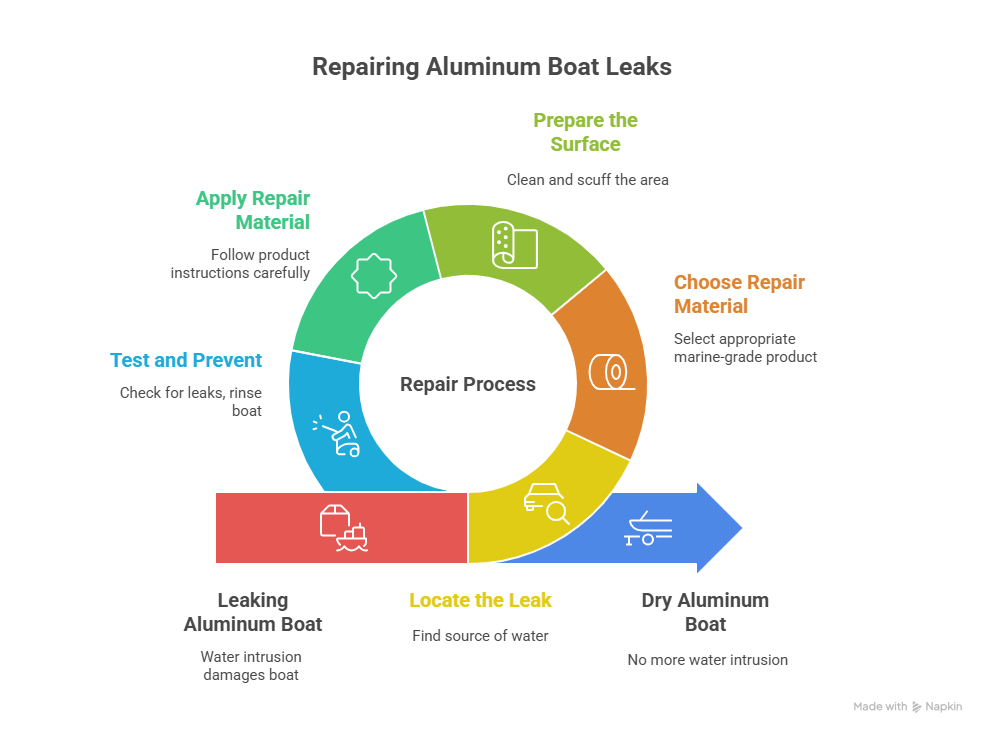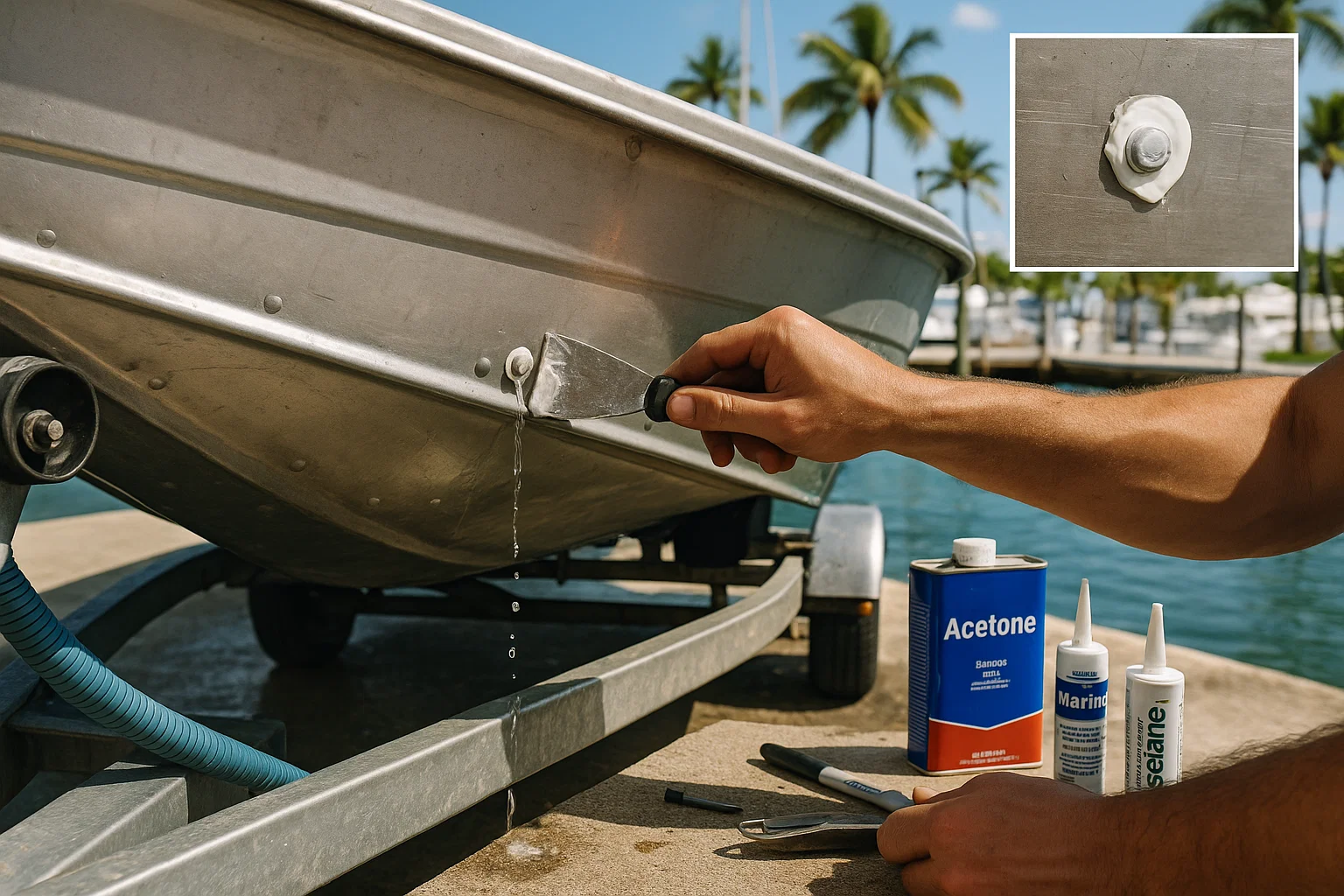How to Repair Aluminum Boat Leaks – A Mechanic’s Real Talk
I’ve been patching up boats in South Florida for over 15 years, and nothing ruins a day on the water faster than a sneaky leak in your aluminum hull. How to repair aluminum boat leaks is something I get asked about all the time at Dinner Key Marina—folks pull up with puddles in their bilge, frustrated and ready to give up. But here’s the thing: it’s not as tricky as it seems if you do it right. I’ll walk you through it like I’m chatting over coffee at the dock, sharing the steps that have saved hundreds of hulls from Bahia Mar to Key Biscayne. We’ll cover finding those hidden drips, picking the best fixes, and avoiding the mistakes that make leaks come back. How to repair aluminum boat leaks starts with smart detective work, and trust me, I’ve seen my share of botched jobs that could’ve been avoided.
Table of Contents
Locating the Leak: Playing Detective on Your Hull
Finding the source is the first big step in how to repair aluminum boat leaks—skip it, and you’re just guessing. I’ve had owners bring in boats where a tiny rivet drip turned into a full flood because they patched the wrong spot. Last summer, a guy named Miguel at Coconut Grove had his 16′ Alumacraft pooling water; we used the fill-and-find method, and it revealed three hidden cracks he never would’ve spotted. How to repair aluminum boat leaks effectively means knowing exactly where the water’s sneaking in, especially in our salty, humid marinas where corrosion loves to hide.
Common Culprits: High-Stress Spots to Check First
Start your search in the usual trouble areas—I’ve fixed enough of these to know where leaks love to hide. Rivets loosen from vibration, seams crack from impacts, and transoms weep around mounts. Focus on loose rivets, cracked welds, and transom screw holes; they’re the hotspots. One time, Sofia’s Jon boat off Stiltsville had a transom leak that looked minor but was eating away at the structure—classic South Florida saltwater issue.
The “Fill and Find” Method – My Go-To Trick
This is how to repair aluminum boat leaks without wasting time: do it on land, methodically. Park the boat level, bow up a bit, plug the drain, and add a few inches of water inside. Circle every outside drip with a marker—be thorough. I remember Javier’s SeaArk last June; we marked five spots, and fixing them all saved him from a $800 redo. It’s simple but foolproof for pinpointing leaks.
Choosing Your Repair Material: What Works and What Doesn’t
Once you’ve found the leaks, picking the right stuff is key in how to repair aluminum boat leaks—wrong choice, and it’ll fail in a week. I’ve seen too many hardware store hacks peel off in Biscayne Bay’s chop. But hey, to make it clearer, I threw together this table from jobs I’ve done in Miami—costs and when to use what, based on real fixes like that time Ray’s Starcraft needed a full seam seal.
| Repair Material | Best For | Average Cost (Miami Area) | Pros/Cons from My Jobs |
|---|---|---|---|
| Two-Part Marine Epoxy | Small holes, hairline cracks | $20–$50 per kit | Rock-hard bond, but needs perfect prep—saved a transom once. |
| Flexible Marine Sealant | Long seams, rivet clusters | $15–$40 per tube | Flexes with hull, waterproof—great for vibrations, but not structural. |
| Aluminum Patch Kit | Larger punctures | $50–$150 | Strong mechanical fix—no welding, but add epoxy for seal. |
| Avoid: Silicone Caulk | Nothing—fails in water | Cheap, but worthless | Peels off fast—I’ve removed tons of this junk. |
How to repair aluminum boat leaks boils down to matching the material to the damage—epoxy for isolated spots, sealants for flexy areas.
The Go-To: Marine-Grade Epoxy for Solid Fixes
For most leaks, grab a two-part marine epoxy—it’s like liquid armor. Best for small holes and cracks, it bonds chemically to aluminum. I used Marine-Tex on Carla’s 18′ tracker boat at Bahia Mar; mixed it right, and that rock-hard patch held through hurricane season. How to repair aluminum boat leaks with epoxy? Prep is everything—clean and scuff, or it won’t stick.
Flexible Options: Marine Sealants for Moving Parts
For seams or rivets that flex, a flexible sealant like Gluvit is your friend—it moves with the hull. Applied like paint, it seals gaps without cracking. Ronnie’s rig off Key Biscayne had weeping rivets; a quick coat stopped the drips for good. This is key in how to repair aluminum boat leaks where rigidity would fail.
Stuff to Skip: Hardware Store Traps
Avoid standard caulk or silicone—they’re not marine-grade and dissolve in water. I’ve scraped off failed patches that cost owners double. Stick to pro products for a lasting fix.

Prepping and Applying: The Hands-On Steps
Prep is non-negotiable in how to repair aluminum boat leaks—100% of success depends on a clean surface. Grind to bright metal, wipe with acetone, then apply. For epoxy, mix and press in; for sealants, bead and smooth. Carlos at Dinner Key ignored prep once—his fix lasted a month. How to repair aluminum boat leaks right means taking time here.
Safety and Tools You’ll Need
Gloves, respirator, grinder—don’t skip PPE. I’ve got scars from skipping it early on.
Testing and Prevention: Keeping It Dry Long-Term
After fixing, test with water—hose it down and check. Prevent with rinses and anodes. Half my calls could’ve been avoided with that.
Wrapping It Up
How to repair aluminum boat leaks is all about method: find, prep, fix, test. I’ve patched enough to know shortcuts bite back—like when I rushed a rivet job and it leaked again. Follow this, and your hull stays dry.
FAQ – Dockside Questions I Hear All the Time
Straight answers from my years fixing leaks—no BS.
How do I know if it’s a leak or condensation?
Fill-and-find shows real drips. Condensation evaporates; leaks pool.
Can I repair underwater leaks?
Drain first—dry hulls only. Towed a guy’s boat from Stiltsville once because he tried wet.
Epoxy or sealant for rivets?
Sealant for clusters; it’s flexible. Epoxy for singles.
How long until it’s water-ready?
24–48 hours cure time. Rushed a job in Miami heat once—failed fast.
Prevention tips?
Rinse after use, check anodes. Saves big on how to repair aluminum boat leaks calls.
DIY or pro for big leaks?
DIY small; pro for structural. I’ve seen DIY disasters turn costly.
Author Bio
I’m Alex, a 15-year marine technician in South Florida, ABYC-certified, with 200+ aluminum boat leak repairs under my belt. From rivet fixes on Jon boats to full seam seals on trackers and whalers, I’ve stopped leaks on them all at marinas like Dinner Key and Bahia Mar, keeping hulls watertight in our corrosive saltwater.


Leave a Reply